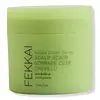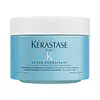What's inside
What's inside
 Key Ingredients
Key Ingredients

 Benefits
Benefits

 Concerns
Concerns

 Ingredients Side-by-side
Ingredients Side-by-side

Water
Skin ConditioningCetearyl Alcohol
EmollientOryza Sativa Powder
Brassicamidopropyl Dimethylamine
Skin ConditioningBehentrimonium Chloride
PreservativeBrassica Alcohol
EmollientCetyl Esters
EmollientTriheptanoin
Skin ConditioningZingiber Officinale Root Powder
Skin ConditioningPyrus Malus Fruit Extract
Skin ConditioningVinegar
Piper Nigrum Fruit Powder
Skin ConditioningCetyl Alcohol
EmollientBrassicyl Valinate Esylate
EmollientJojoba Esters
EmollientHydrogenated Ethylhexyl Olivate
EmollientGlycerin
HumectantPropanediol
SolventTrehalose
HumectantPelvetia Canaliculata Extract
Skin ProtectingHelianthus Annuus Seed Wax
Skin ConditioningLeptospermum Scoparium Branch/Leaf Oil
TonicPanthenol
Skin ConditioningMagnolia Officinalis Bark Extract
AntimicrobialEpilobium Angustifolium Flower/Leaf/Stem Extract
Skin ConditioningZingiber Officinale Root Extract
MaskingPhaeodactylum Tricornutum Extract
HumectantLavandula Angustifolia Flower Extract
CleansingSalvia Hispanica Seed Extract
EmollientRosmarinus Officinalis Leaf Extract
AntimicrobialLeontopodium Alpinum Extract
Skin ConditioningPiper Nigrum Seed Extract
RefreshingCaesalpinia Spinosa Fruit Extract
Skin ProtectingHelianthus Annuus Sprout Extract
Skin ConditioningHelianthus Annuus Extract
EmollientHydrolyzed Vegetable Protein
Skin ConditioningOryza Sativa Seed Protein
AntioxidantOryza Sativa Extract
AbsorbentOryza Sativa Bran Extract
Skin ConditioningGuar Hydroxypropyltrimonium Chloride
Skin ConditioningXylitol
HumectantHydrogenated Olive Oil Unsaponifiables
EmollientArginine PCA
HumectantSalicylic Acid
MaskingTocopherol
AntioxidantMaltodextrin
AbsorbentGluconolactone
Skin ConditioningGalactaric Acid
Calcium Gluconate
HumectantPolyglycerin-3
HumectantCaprylyl Glucoside
CleansingPolysorbate 60
EmulsifyingOctyldodecanol
EmollientSorbitan Oleate
EmulsifyingEthyl Linoleate
EmollientEthyl Oleate
EmollientPolyquaternium-37
Potassium Sorbate
PreservativeSodium Benzoate
MaskingSorbic Acid
PreservativeBenzoic Acid
MaskingSodium Phosphate
BufferingPhytic Acid
Caprylic Acid
CleansingEthylhexylglycerin
Skin ConditioningBenzyl Alcohol
PerfumingChlorphenesin
AntimicrobialCaprylyl Glycol
EmollientPhenoxyethanol
PreservativeParfum
MaskingSodium Metabisulfite
AntioxidantC13-16 Isoparaffin
SolventCitric Acid
BufferingPotassium Hydroxide
BufferingLimonene
PerfumingLinalool
PerfumingCitronellol
PerfumingPentaerythrityl Tetra-Di-T-Butyl Hydroxyhydrocinnamate
AntioxidantWater, Cetearyl Alcohol, Oryza Sativa Powder, Brassicamidopropyl Dimethylamine, Behentrimonium Chloride, Brassica Alcohol, Cetyl Esters, Triheptanoin, Zingiber Officinale Root Powder, Pyrus Malus Fruit Extract, Vinegar, Piper Nigrum Fruit Powder, Cetyl Alcohol, Brassicyl Valinate Esylate, Jojoba Esters, Hydrogenated Ethylhexyl Olivate, Glycerin, Propanediol, Trehalose, Pelvetia Canaliculata Extract, Helianthus Annuus Seed Wax, Leptospermum Scoparium Branch/Leaf Oil, Panthenol, Magnolia Officinalis Bark Extract, Epilobium Angustifolium Flower/Leaf/Stem Extract, Zingiber Officinale Root Extract, Phaeodactylum Tricornutum Extract, Lavandula Angustifolia Flower Extract, Salvia Hispanica Seed Extract, Rosmarinus Officinalis Leaf Extract, Leontopodium Alpinum Extract, Piper Nigrum Seed Extract, Caesalpinia Spinosa Fruit Extract, Helianthus Annuus Sprout Extract, Helianthus Annuus Extract, Hydrolyzed Vegetable Protein, Oryza Sativa Seed Protein, Oryza Sativa Extract, Oryza Sativa Bran Extract, Guar Hydroxypropyltrimonium Chloride, Xylitol, Hydrogenated Olive Oil Unsaponifiables, Arginine PCA, Salicylic Acid, Tocopherol, Maltodextrin, Gluconolactone, Galactaric Acid, Calcium Gluconate, Polyglycerin-3, Caprylyl Glucoside, Polysorbate 60, Octyldodecanol, Sorbitan Oleate, Ethyl Linoleate, Ethyl Oleate, Polyquaternium-37, Potassium Sorbate, Sodium Benzoate, Sorbic Acid, Benzoic Acid, Sodium Phosphate, Phytic Acid, Caprylic Acid, Ethylhexylglycerin, Benzyl Alcohol, Chlorphenesin, Caprylyl Glycol, Phenoxyethanol, Parfum, Sodium Metabisulfite, C13-16 Isoparaffin, Citric Acid, Potassium Hydroxide, Limonene, Linalool, Citronellol, Pentaerythrityl Tetra-Di-T-Butyl Hydroxyhydrocinnamate
Sodium Chloride
MaskingWater
Skin ConditioningSodium Laureth Sulfate
CleansingMaris Sal
Skin ConditioningCocamide Mipa
EmulsifyingPEG-100 Stearate
Glyceryl Stearate
EmollientParfum
MaskingSodium Hydroxide
BufferingCitric Acid
BufferingMenthol
MaskingSalicylic Acid
MaskingPyridoxine Hcl
Skin ConditioningHydroxypropyl Guar Hydroxypropyltrimonium Chloride
Limonene
PerfumingLinalool
PerfumingCeramide AP
Skin ConditioningAlternatives
Ingredients Explained
These ingredients are found in both products.
Ingredients higher up in an ingredient list are typically present in a larger amount.
Citric Acid is an alpha hydroxy acid (AHA) naturally found in citrus fruits like oranges, lemons, and limes.
Like other AHAs, citric acid can exfoliate skin by breaking down the bonds that hold dead skin cells together. This helps reveal smoother and brighter skin underneath.
However, this exfoliating effect only happens at high concentrations (20%) which can be hard to find in cosmetic products.
Due to this, citric acid is usually included in small amounts as a pH adjuster. This helps keep products slightly more acidic and compatible with skin's natural pH.
In skincare formulas, citric acid can:
While it can provide some skin benefits, research shows lactic acid and glycolic acid are generally more effective and less irritating exfoliants.
Most citric acid used in skincare today is made by fermenting sugars (usually from molasses). This synthetic version is identical to the natural citrus form but easier to stabilize and use in formulations.
Read more about some other popular AHA's here:
Learn more about Citric AcidLimonene is a fragrance that adds scent and taste to a formulation.
It's found in the peel oil of citrus fruits and other plants such as lavender and eucalyptus. The scent of limonene is generally described as "sweet citrus".
Limonene acts as an antioxidant, meaning it helps neutralize free radicals.
When exposed to air, oxidized limonene may sensitize the skin. Because of this, limonene is often avoided by people with sensitive skin.
The term 'fragrance' is not regulated in many countries. In many cases, it is up to the brand to define this term. For instance, many brands choose to label themselves as "fragrance-free" because they are not using synthetic fragrances. However, their products may still contain ingredients such as essential oils that are considered a fragrance.
Learn more about LimoneneLinalool is a fragrance and helps add scent to products. It's derived from common plants such as cinnamon, mint, citrus, and lavender.
Like Limonene, this ingredient oxidizes when exposed to air. Oxidized linalool can cause allergies and skin sensitivity.
This ingredient has a scent that is floral, spicy tropical, and citrus-like.
Learn more about LinaloolParfum is a catch-all term for an ingredient or more that is used to give a scent to products.
Also called "fragrance", this ingredient can be a blend of hundreds of chemicals or plant oils. This means every product with "fragrance" or "parfum" in the ingredients list is a different mixture.
For instance, Habanolide is a proprietary trade name for a specific aroma chemical. When used as a fragrance ingredient in cosmetics, most aroma chemicals fall under the broad labeling category of “FRAGRANCE” or “PARFUM” according to EU and US regulations.
The term 'parfum' or 'fragrance' is not regulated in many countries. In many cases, it is up to the brand to define this term.
For instance, many brands choose to label themselves as "fragrance-free" because they are not using synthetic fragrances. However, their products may still contain ingredients such as essential oils that are considered a fragrance by INCI standards.
One example is Calendula flower extract. Calendula is an essential oil that still imparts a scent or 'fragrance'.
Depending on the blend, the ingredients in the mixture can cause allergies and sensitivities on the skin. Some ingredients that are known EU allergens include linalool and citronellol.
Parfum can also be used to mask or cover an unpleasant scent.
The bottom line is: not all fragrances/parfum/ingredients are created equally. If you are worried about fragrances, we recommend taking a closer look at an ingredient. And of course, we always recommend speaking with a professional.
Learn more about ParfumSalicylic Acid (also known as beta hydroxy acid or BHA) is a well-known ingredient for treating skin that struggles with acne and clogged pores. It exfoliates both the skin's surface and deep within the pores to help clear out buildup, control oil, and reduce inflammation.
Unlike AHAs (alpha hydroxy acids), salicylic acid is oil-soluble. This allows it to penetrate into pores which makes it especially effective for treating blackheads and preventing future breakouts.
Salicylic acid is also known for its soothing properties. It has a similar structure to aspirin and can calm inflamed or irritated skin, making it a good option for acne-prone skin that is also sensitive.
Concentrations of 0.5-2% are recognized by the U.S. FDA as an over-the-counter topical acne product.
It can cause irritation and/or dryness if one's skin already has a compromised moisture barrier, so it's best to focus on repairing that before introducing this ingredient into your routine.
While salicylic acid does not increase sun sensitivity, it’s still important to wear sunscreen daily to protect your skin.
If you are looking for the ingredient called BHA or Butylated Hydroxyanisole, click here.
Learn more about Salicylic AcidWater. It's the most common cosmetic ingredient of all. You'll usually see it at the top of ingredient lists, meaning that it makes up the largest part of the product.
So why is it so popular? Water most often acts as a solvent - this means that it helps dissolve other ingredients into the formulation.
You'll also recognize water as that liquid we all need to stay alive. If you see this, drink a glass of water. Stay hydrated!
Learn more about Water